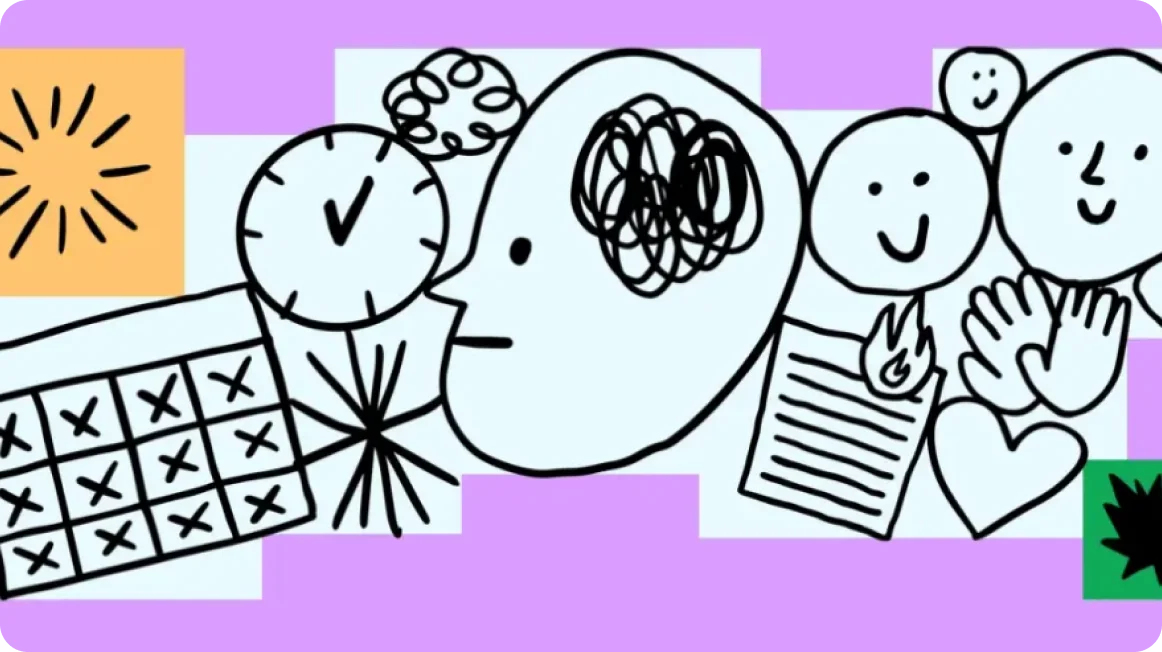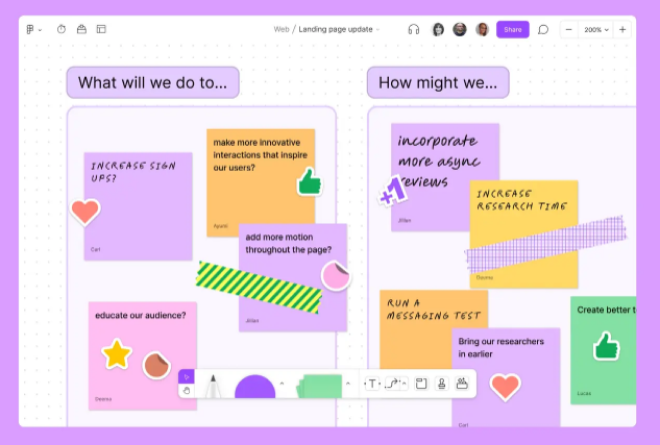- Welcome ideas from all places with a brainstorm
- Sketch it out in 8 different ways
Otvos Mihai | February 23, 2023
Can design make work, work?

In this three-part series, we’ll talk to leaders and managers from teams at Shopify, Ironclad, Twitch, Uber, and more to learn about how they’re rethinking the way they work to keep pace with the outsized change in work right now. For part one, we will focus on the unique view people managers have on the dynamics and challenges at work today, and how taking some simple cues from design can turn that vantage point into an advantage.
There is, quite literally, no time like the present. If you’re a people manager, you’re probably feeling this pretty acutely (especially the “no time” part). With corporate life undergoing a seismic shift, change has become the only constant at work. Between navigating the nuances of hybrid work, contending with an onslaught of technological advancements (and distractions), and motivating teams in an era of upheaval, your job has undoubtedly become more difficult.
But look at it another way: The sheer lack of a baseline “normal” can also be freeing—a carte blanche to reimagine the future of work, starting with your own job as a people leader. So if you are questioning how you’re spending your time, or wondering how to connect with your team in a way that brings more value, energy, and output to your work, start here. In this series, we’ll dive into some real world inspiration to help you map a WIP future—a future that embraces change for the sake of ourselves, our teams, and our work. Let’s call it a redesign. Step one? Take radical stock of the job you have in order to transform it into the job you want.
Why spending less time together might bring your team closer
At the start of 2023, Shopify took the dramatic step of purging all recurring meetings with more than three people, later gradually adding back the most critical, so employees could work without interruption. As radical as it seems, canceling every meeting reflects people’s basic need for time to work independently. Shopify is fully remote, and to collaborate effectively, employees contribute when they can to “always on” collaborative Figma and FigJam files. “Our team is distributed across many time zones, so it’s hard to have meetings,” says Sebastian Speier, a Senior UX Manager at Shopify. “Tools that allow us to collaborate asynchronously, we really want to invest in those.” To free up your schedule, try seeking out other ways to connect. Building “culture” might sound squishy, but it’s also pretty straightforward: Make sure your people have the time, space, and resources to be great at their jobs. Bringing topics you usually cover in standup and planning meetings gives ideas room to breathe.
Bringing topics you usually cover in standup and planning meetings gives ideas room to breathe.
As for your time? Be brutally honest: What do you do all day, and how neatly does it align with what your boss, or your boss’s boss, thinks you do? Executives tend to think managers focus on high-level tasks, such as leading institutional change and helping employees chart their personal growth. Managers, meanwhile, tend to find themselves tackling more mundane problems, like how (or whether) to hold meetings and find talent. Start taking back your time by using collaboration tools and visualization strategies to streamline your meetings—or better yet, get rid of them altogether. Moving work forward doesn’t always mean “let’s meet.” When you do, think about how you can make that time more about building interpersonal connections—starting with conversations that are less about substantive "outcomes" and more about an attitude or philosophy towards the work.
Do something better with your time (asynchronously)
There is, quite literally, no time like the present. If you’re a people manager, you’re probably feeling this pretty acutely (especially the “no time” part). With corporate life undergoing a seismic shift, change has become the only constant at work. Between navigating the nuances of hybrid work, contending with an onslaught of technological advancements (and distractions), and motivating teams in an era of upheaval, your job has undoubtedly become more difficult.
But look at it another way: The sheer lack of a baseline “normal” can also be freeing—a carte blanche to reimagine the future of work, starting with your own job as a people leader. So if you are questioning how you’re spending your time, or wondering how to connect with your team in a way that brings more value, energy, and output to your work, start here. In this series, we’ll dive into some real world inspiration to help you map a WIP future—a future that embraces change for the sake of ourselves, our teams, and our work. Let’s call it a redesign. Step one? Take radical stock of the job you have in order to transform it into the job you want.
Decline every meeting
Why spending less time together might bring your team closer
At the start of 2023, Shopify took the dramatic step of purging all recurring meetings with more than three people, later gradually adding back the most critical, so employees could work without interruption. As radical as it seems, canceling every meeting reflects people’s basic need for time to work independently. Shopify is fully remote, and to collaborate effectively, employees contribute when they can to “always on” collaborative Figma and FigJam files. “Our team is distributed across many time zones, so it’s hard to have meetings,” says Sebastian Speier, a Senior UX Manager at Shopify. “Tools that allow us to collaborate asynchronously, we really want to invest in those.” To free up your schedule, try seeking out other ways to connect. Building “culture” might sound squishy, but it’s also pretty straightforward: Make sure your people have the time, space, and resources to be great at their jobs.

As for your time? Be brutally honest: What do you do all day, and how neatly does it align with what your boss, or your boss’s boss, thinks you do? Executives tend to think managers focus on high-level tasks, such as leading institutional change and helping employees chart their personal growth. Managers, meanwhile, tend to find themselves tackling more mundane problems, like how (or whether) to hold meetings and find talent. Start taking back your time by using collaboration tools and visualization strategies to streamline your meetings—or better yet, get rid of them altogether. Moving work forward doesn’t always mean “let’s meet.” When you do, think about how you can make that time more about building interpersonal connections—starting with conversations that are less about substantive "outcomes" and more about an attitude or philosophy towards the work.
Do something better with your time (asynchronously)
